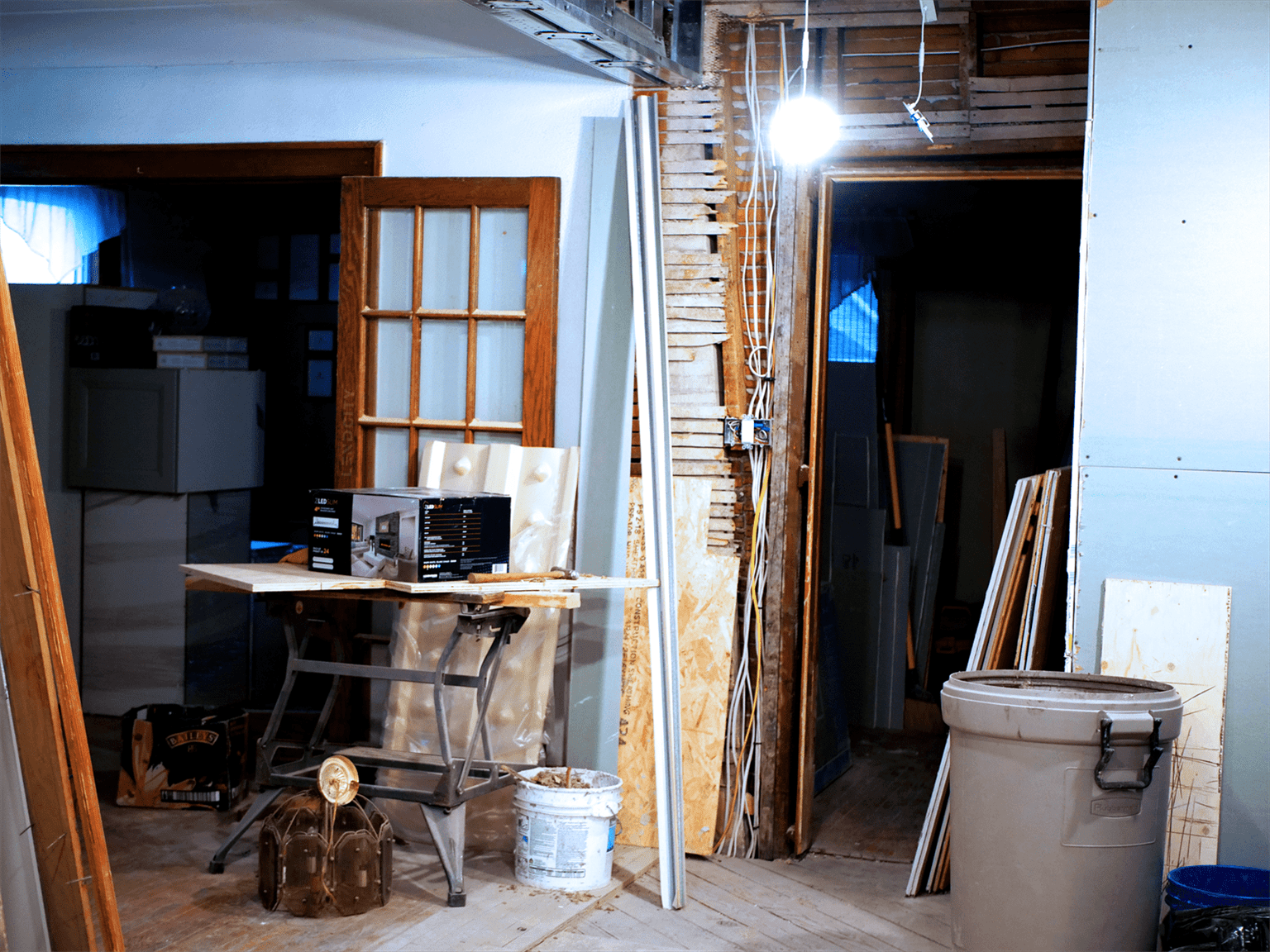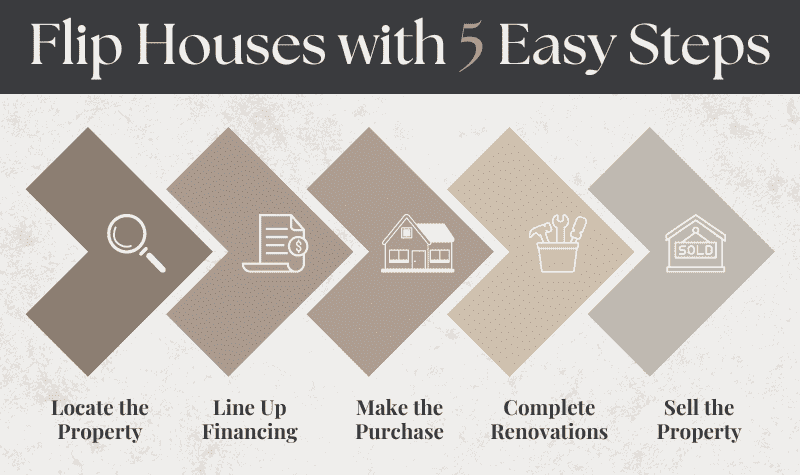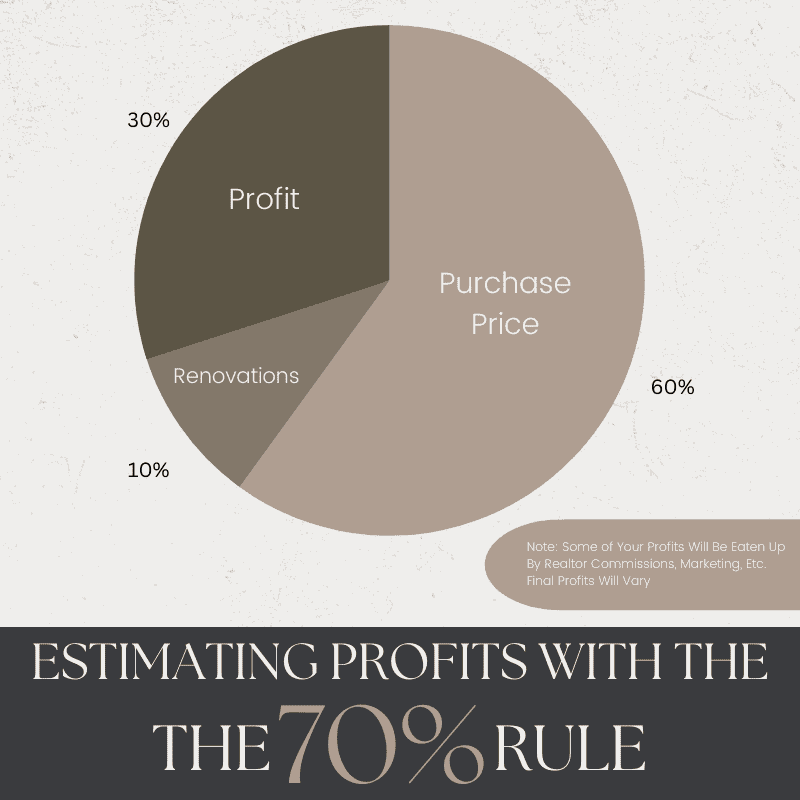Flipping Houses: Step-By-Step Guide - New

In real estate investing, buying a house and reselling it for a profit is one of the most popular strategies for novice investors looking for a quick return. This is also known as “flipping” a house.
This process sees buyers purchase a home in an up-and-coming neighbourhood. After adding a few renovations, the buyer then turns around and sells the home to someone who will presumably live there for some time to come.
When it comes to flipping houses Canada is an excellent place to get started because of the consistent growth the market is experiencing year-over-year.
Flipping a house seems like a relatively straightforward process from the outside, but once you enter the market for the first time, you will discover that there are several factors you never counted on. Not to worry, this is one new enterprise you can navigate. You just need to know the basics.
However, the first thing that I would put at the top of my flipping a house checklist is a pre-approval. Flipping is all about knowing your budget and sticking to it. A pre-approval helps you know exactly what your budget is so that you can strategize more effectively. Not all lenders support flipping houses and some that do have large penalties and fees. It's best if you want to invest to ensure you have the correct lender.
So, let my team and I set you up with a pre-approval today by booking a free strategy call at this link.
Rule #1 - Don't Get Stressed
The phrase “expect the unexpected” hardly applies to anything as much as it applies to the real estate market, especially when you’re a first-timer trying to flip a home. Before you invest for the first time, you should try to accept that things will get complicated. The unforeseen will happen. You will end up juggling multiple tasks at every stage.
Flipping a house is a hectic endeavour, especially at first, so try to stay aware of your stress levels and take breaks as needed.
You should also remember that along the way you will have the support of your team to make things easier to manage. This includes your realtor, contractors, and the financing team here at LendCity.
I promise you, that as long as you remember to trust your team, you will quickly learn what makes flipping houses Canada's most exciting investment method - or at least one of them.
5 Easy Steps to Flipping a House
I know that flipping houses can be an intimidating project for a new investor. So, consider this my guide for "how to flip houses for beginners."
Of course, the truth is that this information is essential for flippers at all levels.
While there are plenty of things to keep in mind each step of that way, the steps to flipping a house can be broken down into five simple steps.
Locate an Ideal Property
The first step and arguably the most important step when you are flipping houses is to locate an ideal property.
While there is potential to turn nearly any property into a strong real estate investment, most properties are not suited for flipping. So, you need to learn what to spot.
Most of the time, when you are flipping a house you should be looking for undervalued and, distressed properties that have visible room for improvement.
Note that I am saying distressed, not destroyed. If the damage on a property has too many damages or requires serious work, your renovation costs will likely exceed the value you can expect to build in the property.
Instead, what you need to find is a property that can be repaired and renovated affordably while also introducing new value into the property.
Renovations that can be done relatively affordably while still introducing new value include:
- Replacing or Repairing Doors and Windows
- Updating Flooring
- Repair and Repaint the Walls
- Repair or Replace Cabinetry
- Remove Mold, Mildew, and Water Damage (Non-Severe)
- Update the Light Fixtures
- Updating the Bathroom or Kitchen
As well, if you can locate an off-market property, you may be able to secure a flip with high-potential for even less.
Download your FREE Printable Excerpt for this Step By Step Guide
Identifying Motivated Sellers
On top of identifying the key areas where a property can be improved upon, another key way to find great flipping houses is to identify motivated sellers.
These are people who have extra motivation to unload a property that they cannot maintain or were not prepared to take care of.
Many motivated sellers wind up in their position due to sudden life events such as death or divorce leaving them in charge of a property beyond their means.
To get rid of the property even faster, many motivated sellers will accept lowball offers on their property, helping you save money on the purchase and dedicate more funds towards the flip.
Line Up Your Financing
Once you know which property you would like to purchase, it is time to get your financing sorted. What you want is a low-cost mortgage with little to no penalties for breaking your term when you eventually sell the property.
Fortunately, with your pre-approval in hand, this should be a relatively easy process. However, if you did not elect to get a pre-approval, we can still help you.
In order to get the right mortgage for your flip, simply book a strategy call right here, and let me and my team get you sorted.
Buy The Property
After you have your mortgage financing in order, it is time to complete the purchase.
Remember when you are buying the property to take the time to negotiate your closing costs. Sometimes if you are skilled enough at negotiating, you can save hundreds or even thousands on the purchase.
Complete the Flip
When you enter the remodeling phase, you want to walk a tightrope between adding exciting frills and making sure your home remains affordable. A lot of professionals that are flipping houses advocate the installation of fun stuff like steam showers and home theatres. These touches can undoubtedly make your home pop out in the mind of potential buyers. That much is true, but it is also crucial not to go overboard.
I have seen many investors lose money on the sale because they were not careful with their flipping costs. So, what I suggest is that you take the time to shop around for all of your materials and contractors to make sure that you are getting the best quality at the most reasonable price.
When you’re estimating your final After Repair Value, make sure that you are pricing your new home alongside the other houses in the neighbourhood. You can work alongside your real estate agent to project neighbourhood growth, but even then, keep it contained. There’s nothing worse than pouring thousands into gorgeous upgrades to discover that your home’s market value is ten and twenty thousand more than the house next door. Even a state-of-the-art home theatre isn’t worth that kind of price increase.

Make The Sale
After the flip is completed, it is time to sell the property and reap the reward.
When you are listing the property, take the time to get professional photos taken that show off all of the updated features. The new and improved value of the home is your main selling point.
Make sure when you're flipping houses that you are not accepting any lowball offers unless it is absolutely necessary. Otherwise, compromising on the sale will eat into your final profits.
It is also important to remember that Canada has introduced a new tax on flipping houses that impacts properties bought and sold within a 12-month period. So, you need to factor that in to your closing costs on the sale.
Don't Underestimate The Value of a Great Realtor
That being said, the majority of the stress that comes from flipping houses can be taken off of your shoulders by using a great realtor you can trust.
I find that by partnering with a skilled realtor the listing and sale process can go by much more smoothly.
While you will need to worry about their commission at the end, the value they add to any real estate deal easily pays for it.
Just make sure to choose a veteran agent who is familiar with the neighbourhoods they work in. Keep in mind that you will hopefully end up flipping houses for several years to come, so it’s critical to pick a real estate agent that you respect and that you can get along with.
With careful research and plenty of professional help, you too can flip homes for a profit—a great way to start your portfolio.
Understanding the 70% Rule
If you have been listening to investors talk about house flipping for any length of time, you have likely heard about the 70 percent rule and have the same question most new investors have.
What is the 70% rule in house flipping?
When you enter the market, you’ll have certain expectations about how things will turn out. While the ideal scenario will likely never play out, it’s still good to have some idea of what to shoot for. The primary number you’ll be working with is called the ARV, or After Repair Value. This metric refers to—you guessed it—the value of the home after you’ve remodeled and put it back on the market.
In a perfect world, you will purchase a home at 40 to 60 percent of a home’s ARV and then upgrade it to around 70 percent of the ARV. Hopefully, you can subsequently sell the house for 100 percent of its ARV. That’s a 30 percent pure profit, about half of which will go to paying down financing and sales fees. So, at the end of the day, you will hope to pocket around 10-15 percent of the homes After Repair Value.
That means you don't need to waste time worrying about the average net profit for flipping a house. Instead, you can spend your time looking at larger percentages and building your budget around those instead.

Is House Flipping a DIY Project?
Some investors look at house flipping as their opportunity to try their hand at DIY renovations. However, in my opinion that is usually a bad idea.
When you have a house to flip, you do not want to waste time on redoing renovations and repair jobs that you could have left to an experienced professional. The time and materials you are going to spend trying to do the work yourself will almost always be better spent on an experienced contractor.
You can save some money by doing the easy stuff—replacing ceiling fans, painting, putting up shelves and more—but when it comes to laying down carpet, putting in new fixtures, remodeling entire rooms or putting in tile, you want backup from a pro.
Now obviously there may be exceptions if you are experienced in certain forms of renovations and can confidently do the job correctly the first time. However, that is an exception, not the rule.
I know personally, I would rather trust the contractors I have hired to do the work than try it myself and wind up essentially paying for the same work twice once they need to fix my mistakes.
Flipping Houses For Less
House flipping can be an expensive project to take on as an investor. However, there are ways to flip real estate for less.
If you are looking to learn how to flip a house with just $20k, we can introduce you to a great flipping lender.
While these low-cost options are not available to all investors, we will take the time to help you secure the most affordable financing for your next flip so that you can spend less time crunching the number and more time completing the flip.
All you need to do is visit this link and book a strategy call with my team today.
